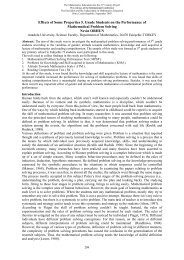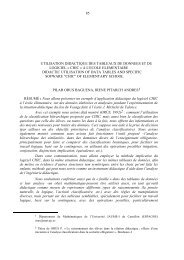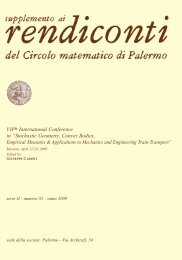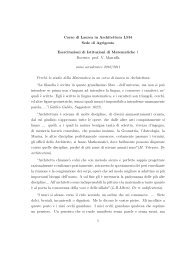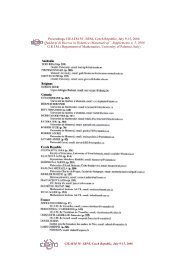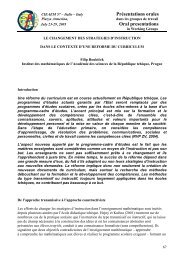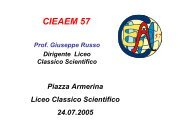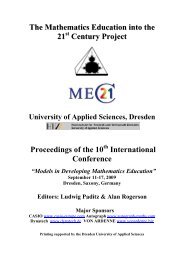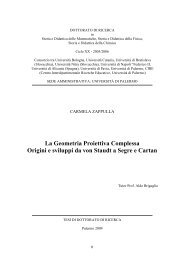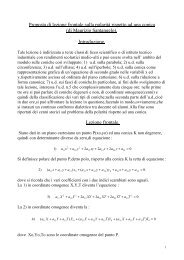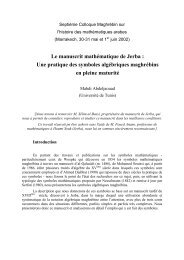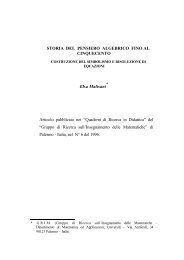CONTENTS - Dipartimento di Matematica e Informatica
CONTENTS - Dipartimento di Matematica e Informatica
CONTENTS - Dipartimento di Matematica e Informatica
You also want an ePaper? Increase the reach of your titles
YUMPU automatically turns print PDFs into web optimized ePapers that Google loves.
Resnick, Singer (1993); Karplus, West (1994); Confrey (1994, 1995) have all made<br />
important contributions concerning the same field of enquiry.<br />
In the following pages, in order to study the <strong>di</strong>fferent ideas of “fraction” and general<br />
educational problems in the learning of fractions, and in order to supply some<br />
educational suggestions, I shall make reference to some results of the following specific<br />
works.<br />
Adjiage, Pluvinage (2000) illustrate the results of a test administered in class over a<br />
period of 2 years in which the single rather than a two-<strong>di</strong>mensional geometrical<br />
representation is used. Their conclusion is that the classical two-<strong>di</strong>mensional<br />
representation causes notable <strong>di</strong>fficulties whereas a constant, balanced use of both can<br />
reduce those <strong>di</strong>fficulties. They also underline the importance of making reference to<br />
sizes which are common in the everyday lives of pupils, something already emphasised<br />
by Carraher, Dias Schliemann (1991).<br />
Keijzer, Terwel (2001) present a interesting “case study” conducted over a period of 30<br />
lessons in a Primary school in Holland. The objective was to construct a series of basic<br />
skills in handling fractions. The authors describe the process of defining objectives, the<br />
single lessons, the constructing of learning and the tests used to assess the skills<br />
developed, taking account of research into preventing and overcoming <strong>di</strong>fficulties. The<br />
study contains interviews between teachers and learners as well as <strong>di</strong>agrams and<br />
drawing produced by the latter. The study is based on the fin<strong>di</strong>ngs contained in Keijzer,<br />
Buys (1996) (which also contains a specific proposal for a curriculum).<br />
O’Connor (2001) presents a <strong>di</strong>scussion group of fifth year Primary school children who<br />
consider the question: “Can any fraction be transformed into a decimal number?”. The<br />
objective is to show how the work of teachers often encounters problems arising from<br />
in<strong>di</strong>vidual personal interpretations on the part of students, due both to mathematical<br />
complications and <strong>di</strong>fficulties with calculations. The study is particularly useful for the<br />
way in which it sheds light on spontaneous constructions of knowledge.<br />
Llinares (2003) (in Chamorro ed., 2003, Chapter 7) examines Mathematics Education at<br />
Primary, considering the basic elements of the <strong>di</strong>scipline together with general and<br />
specific aspects of teaching research, and thus provi<strong>di</strong>ng a compen<strong>di</strong>um of this work,<br />
based on experiences in the Spanish and Latin American world is certainly of great<br />
interest for future developments in the field. Clearly this work will be useful in the last<br />
chapter of our paper.<br />
In Spain much research has been conducted in the field, inclu<strong>di</strong>ng work published in<br />
Castro ed. (2001), chapters on fractions and decimal numbers (Castro, Torralbo, 2001),<br />
15




